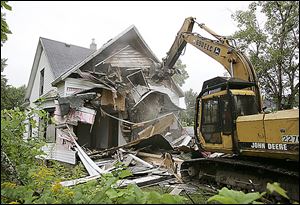
Kasich asked to spur home demolitions
Ohio senators want foreclosure funds spent on removing blight
6/20/2013
Toledo has about 3,000 neglected dwellings awaiting a date with the wrecking ball, but not enough money to handle that number. The release of state foreclosure funds could help meet that need.
Nearly five years after the national housing market collapsed, triggering an avalanche of foreclosures around the country, the state of Ohio still has about $375 million waiting to be spent on “foreclosure prevention.”
A move is now afoot to dedicate a portion of that money to housing demolition.
With about 3,000 neglected dwellings awaiting a date with the wrecking ball, Toledo would welcome getting a share of that cash.
Ohio's U.S. Senators Rob Portman, a Republican, and Sherrod Brown, a Democrat, on Tuesday sent letters to Gov. John Kasich urging him to take advantage of a change in federal policy and spend some of the funds on demolition.
In his letter to the governor, Mr. Portman urged the administration to “request as large of an amount as possible to be used for demolition purposes.”
Mr. Brown's letter said the amount targeted toward demolition should be about 25 percent, while leaving enough to keep housing mortgage counselors on the job.
Doug Garver, executive director of the Ohio Housing Finance Agency, said Ohio has spent about $200 million of its original allotment of $570 million since 2010 from the Hardest Hit Fund and has helped nearly 11,000 Ohio families with their mortgages. He said the state is on track to allocate all the money by mid-2016, well before the Dec. 31, 2017 deadline.
According to the agency's Web site, the maximum amount of assistance per home is $35,000 and the average assistance so far is $14,400. He said Ohio is recognized as one of the states moving the quickest to allocate the money.
“It is a very labor intensive process. It just takes a lot of time. There is no wholesale way to do hundreds of these at one time,” Mr. Garver said.
Michigan recently received permission from the U.S. Department of the Treasury to use the money, which came through the controversial Troubled Assets Relief Program, to pay for demolitions. Mr. Garver said Ohio is now putting together its own proposal for using about $60 million of its unspent money on demolitions.
Officials said it's too early to predict how much of that money could be headed to the city of Toledo. But if the money is distributed in a way similar to the program that was announced earlier this year between the Ohio Attorney General's office and the Lucas County Land Bank, there could be enough cash to bring down hundreds of empty houses.
Earlier this year Ohio received $93 million as part of a nationwide legal settlement with mortgage companies over the “robo-signing” of mortgages that helped trigger the 2008 crisis. Attorney General Mike DeWine dedicated $75 million to housing demolition, of which $3.7 million was earmarked for Toledo. That amount was matched by $3.2 million from the county land bank and $400,000 from the city of Toledo. The plan is to raze 900 homes over an 18-month period.
Normally, the city struggles to demolish 300 vacant homes a year.
“Any dollars coming into our area to do that would be greatly appreciated,” said Lourdes Santiago, director of the city's Department of Neighborhoods.
“They’re unattractive nuisances,” Ms. Santiago said.
She said empty dwellings mar the city's older neighborhoods especially.
“Many of them are abandoned. They are bringing down the property values of other houses that are there,” she said.
Mr. Garver said U.S. Rep. Marcy Kaptur (D., Toledo) is one of three Ohio congressmen who are working on passing a law to expand the use of the money to include demolition. He said the mortgage problems are different in each state.
“In some states the overhang of vacant dilapidated units is not an issue; Florida, Arizona, California. For states in the Midwest such as Ohio and Michigan, it is an issue,” he said.
“We think there is a link between demolition and foreclosure prevention. If you take out vacant units, those families still residing in the area are less likely to walk away,” Mr. Garver said.
Contact Tom Troy at:
tomtroy@theblade.com
or 419-724-6058.